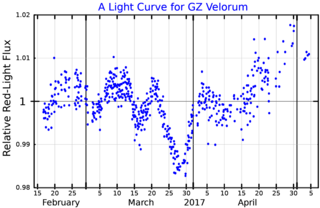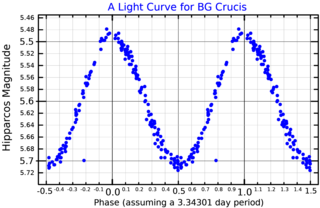Related Research Articles
22 Andromedae, abbreviated 22 And, is a single star in the constellation Andromeda. 22 Andromedae is the Flamsteed designation. It is visible to the naked eye with an apparent visual magnitude of 5.04. The distance to 22 And can be estimated from its annual parallax shift of just 2.2 mas, which shows it to be around 1,500 light years away. It is moving closer to the Earth with a heliocentric radial velocity of −8.2 km/s.

V520 Carinae is a single star in the southern constellation of Carina. It has the Bayer designation w Carinae, while V520 Carinae is a variable star designation. The star has an orange hue and is faintly visible to the naked eye with an apparent visual magnitude that fluctuates around +4.58. It is located at a distance of approximately 1,140 light years from the Sun based on parallax, and it is drifting further away with a radial velocity of +9 km/s. It is a candidate member of the IC 2391 moving group of co-moving stars.
Upsilon2 Centauri is a binary star system in the southern constellation Centaurus. It is visible to the naked eye with an apparent visual magnitude of +4.33. Based upon an annual parallax shift of just 2.57 mas as seen from Earth, this star is located roughly 1,300 light years from the Sun. Relative to its neighbors, the system has a peculiar velocity of 39.2+8.8
−15.2 km/s and it may form a runaway star system.
HD 125288 is a single star in the southern constellation of Centaurus. It has the Bayer designation v Centauri ; while HD 125288 is the star's identifier in the Henry Draper catalogue. The object has a blue-white hue and is faintly visible to the naked eye with an apparent visual magnitude of 4.30. Based on parallax measurements, it is located at a distance of approximately 1,230 light years from the Sun. This is a candidate runaway star that is moving to the west and falling back into the Galactic plane. It has an absolute magnitude of −3.56.

NO Aurigae is a pulsating variable star in the constellation Auriga. It is an unusually-luminous asymptotic giant branch star about 3,500 light years away.
HD 133683 is a single star in the southern constellation of Triangulum Australe. It has a yellow-white hue and is dimly visible to the naked eye with an apparent visual magnitude of +5.76. The distance to this star is approximately 3,600 light-years based on parallax, but it is drifting closer with a radial velocity of −14.7 km/s.
63 Cygni is a single star in the northern constellation of Cygnus, located around 1,030 light years away from Sun. It is visible to the naked eye as an orange-hued star with an apparent visual magnitude of 4.56. 63 Cyg is moving closer to the Earth with a heliocentric radial velocity of −26 km/s.
HD 189276 is a single star in the northern constellation Cygnus, positioned near the northern constellation border with Draco. It has an orange hue and is faintly visible to the naked eye with an apparent visual magnitude of 4.98. The star is located at a distance of approximately 820 light years from the Sun based on parallax, and it has an absolute magnitude of −2.25. It is drifting further away with a radial velocity of +4 km/s. The star has a high peculiar velocity of 38.5+1.8
−2.2 km/s and thus is a probable runaway star.
HD 102350 is a single star in the constellation Centaurus. It has a yellow hue and is visible to the naked eye with an apparent visual magnitude of 4.11. The distance to this star is approximately 390 light years based on parallax, but it is drifting closer with a radial velocity of −3 km/s. It has an absolute magnitude of −1.51.
HD 101570 is a single star in the southern constellation of Centaurus. It has a yellow hue and is faintly visible to the naked eye with an apparent visual magnitude of 4.93. The star is located at a distance of approximately 1,080 light years from the Sun based on parallax, and is drifting further away with a radial velocity of +18 km/s. It has an absolute magnitude of −2.24.
3 Ceti is a single, orange-hued star located around 2,100 light years away in the equatorial constellation of Cetus. It is visible to the naked eye with an apparent visual magnitude of 4.95. The star is moving closer to the Earth with a heliocentric radial velocity of −42 km/s. It has a peculiar velocity of 60.7+3.8
−6.2 km/s and is a candidate runaway star.
HD 115211 is a single star in the southern constellation of Musca. It has an orange hue and is faintly visible to the naked eye with an apparent visual magnitude of 4.86. Its distance from Earth is approximately 1,370 light years based on parallax, and it is drifting closer to the Sun with a radial velocity of −10 km/s. It has an absolute magnitude of −2.94.

Sigma Ophiuchi, Latinized from σ Ophiuchi, is a single, orange-hued star in the equatorial constellation Ophiuchus. Its apparent visual magnitude is 4.31, which is bright enough to be faintly visible to the naked eye. The annual parallax shift of 3.62 mas as seen from Earth provides a distance estimate of roughly 900 light years. It is moving closer to the Sun with a radial velocity of −28 km/s.

20 Puppis is a solitary star in the southern constellation of Puppis. It is visible to the naked eye as a faint, yellow-hued star with an apparent visual magnitude of 4.99. The star lies approximately 990 light years away from the Sun based on parallax. It is receding from the Earth with a heliocentric radial velocity of +16.8 km/s.
HD 161840 is a single, blue-white hued star in the southern zodiac constellation of Scorpius. It is faintly visible to the naked eye with an apparent visual magnitude of 4.79. With an annual parallax shift of 6.5 mas it is located roughly 500 light years from the Sun. It is moving closer with a heliocentric radial velocity of −13 km/s.
139 Tauri is a single, blue-white hued star in the zodiac constellation of Taurus. It is faintly visible to the naked eye with an apparent visual magnitude of 4.81. The distance to this star, as determined from an annual parallax shift of 2.10±0.19 mas, is roughly 1,600 light years. Because this star is located near the ecliptic, it is subject to occultations by the Moon. One such event was observed April 28, 1990.
HD 85622 is a binary star system in the southern constellation of Vela. It is visible to the naked eye with an apparent visual magnitude of 4.58. The distance to HD 85622 can be estimated from its annual parallax shift of 4.3 mas, yielding a value of 750 light years. It is moving further from the Earth with a heliocentric radial velocity of +8 km/s.

GZ Velorum is a single, orange-hued star in the southern constellation of Vela. It is a faint star but visible to the naked eye, having an apparent visual magnitude of 4.58. The star is located around 1,300 light years from Earth, as determined from its annual parallax shift of 2.4 mas. It is moving further away with a heliocentric radial velocity of +13 km/s.

BG Crucis is a suspected binary star system in the southern constellation of Crux. It is visible to the naked eye as a faint yellow-white hued point of light with an apparent visual magnitude that fluctuates around 5.49. The system is located at a distance of approximately 1,830 light years from the Sun based on parallax, and is drifting closer with a radial velocity of −19 km/s.

HD 114533, also known as HR 4976, is a solitary star located in the southern circumpolar constellation Chamaeleon. It has an apparent magnitude of 5.84, making it faintly visible to the naked eye. The system is located relatively far at a distance of roughly 2,100 light years based on Gaia DR3 parallax measurements but is drifting closer with a heliocentric radial velocity of −18 km/s. At its current distance, HD 114533A's brightness is diminished by 0.74 magnitudes due to interstellar dust. It has an absolute magnitude of −2.0.
References
- 1 2 3 4 5 van Leeuwen, F. (2007). "Validation of the new Hipparcos reduction". Astronomy and Astrophysics. 474 (2): 653–664. arXiv: 0708.1752 . Bibcode: 2007A&A...474..653V . doi: 10.1051/0004-6361:20078357 .
- 1 2 3 4 5 6 7 Anderson, E.; Francis, Ch. (2012). "XHIP: An extended hipparcos compilation". Astronomy Letters. 38 (5): 331. arXiv: 1108.4971 . Bibcode:2012AstL...38..331A. doi:10.1134/S1063773712050015. S2CID 119257644.
- 1 2 Malaroda, S. (August 1975). "Study of the F-type stars. I. MK spectral types". Astronomical Journal. 80: 637–641. Bibcode:1975AJ.....80..637M. doi: 10.1086/111786 .
- 1 2 van der Wal, S. E.; van Genderen, A. M. (April 1988). "VBLUW-photometry of the two FO Ib supergiants HD 80404 and HD 90853 and the K5 Ib supergiant HD 85891 with its associated cluster". Astronomy and Astrophysics. 195: 172–178. Bibcode:1988A&A...195..172V.
- 1 2 Hohle, M. M.; et al. (2010). "Masses and luminosities of O- and B-type stars and red supergiants". Astronomische Nachrichten. 331 (4): 349–360. arXiv: 1003.2335 . Bibcode:2010AN....331..349H. doi:10.1002/asna.200911355. S2CID 111387483.
- 1 2 3 4 5 6 Brown, A. G. A.; et al. (Gaia collaboration) (August 2018). "Gaia Data Release 2: Summary of the contents and survey properties". Astronomy & Astrophysics . 616. A1. arXiv: 1804.09365 . Bibcode: 2018A&A...616A...1G . doi: 10.1051/0004-6361/201833051 . Gaia DR2 record for this source at VizieR.
- 1 2 3 4 5 Mallik, Sushma V.; et al. (October 2003). "Lithium and rotation in F and G dwarfs and subgiants". Astronomy and Astrophysics. 409: 251–261. Bibcode:2003A&A...409..251M. doi: 10.1051/0004-6361:20031084 .
- ↑ "HD 90853". SIMBAD . Centre de données astronomiques de Strasbourg . Retrieved 2020-01-26.
- ↑ Eggleton, P. P.; Tokovinin, A. A. (September 2008). "A catalogue of multiplicity among bright stellar systems". Monthly Notices of the Royal Astronomical Society . 389 (2): 869–879. arXiv: 0806.2878 . Bibcode:2008MNRAS.389..869E. doi:10.1111/j.1365-2966.2008.13596.x. S2CID 14878976.
- ↑ Samus, N. N.; et al. (2017). "General Catalogue of Variable Stars". Astronomy Reports. 5.1. 61 (1): 80–88. Bibcode:2017ARep...61...80S. doi:10.1134/S1063772917010085. S2CID 125853869.